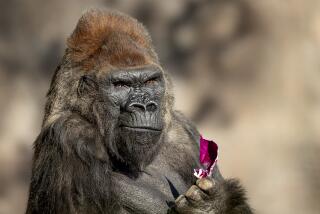Oh Baby! : Gorilla Thrives Under L.A. Zooâs Care, but Custody Battle Means Sheâs Moving
Early one morning in January, a zookeeper found the newborn gorilla lying on the floor of its pen at the Los Angeles Zoo, chilled and with wounds on her head, probably bite marks inflicted by her mother.
The baby, just hours old, was immediately placed in foster care, where she thrives under the doting attention of human caretakers and countless visitors to the zoo nursery. But the opportunity to see the first baby gorilla born at the Los Angeles Zoo since 1987 is limited.
The ape, although born in Los Angeles, belongs to the Albuquerque zoo. (The babyâs grandmother originally came from Albuquerque, and that zoo owns her daughter and granddaughter as a result.) After a brief custody battle, both zoos agreed that the primate will jet off to her permanent home in New Mexico at the end of April.
âI hate to lose the baby,â said Los Angeles Zoo administrator Manuel A. Mollinedo. âSheâs really cute. Sheâs been through a lot.â
In the meantime, the still-unnamed infant--the results of the Name the Baby contest will be announced March 7--spends most of her day in a nursery crib, surrounded by photos of her parents, colorful plastic rings, a rubber ducky and a stuffed toy gorilla.
âThey start out just as a human baby,â said Laurie Hrdlicka, who has run the zoo nursery for 14 years. âThey progress faster,â she added.
At 1 week old, she could hold her head up and roll over by herself. The grip of her hands and feet is already firm--normally crucial for clinging on to her motherâs fur. Her first tooth came in three weeks ago, and three more have pushed through the gums.
Each morning, Hrdlicka takes the babyâs temperature--between 99 and 100 degrees--and weight--now 8 pounds, 3 ounces, more than 2 pounds heavier than when she was born. Hrdlicka then heats up the first of eight bottles of formula the baby will drink in the course of the day. In a few years, the gorillaâs growth will level off at 250 to 300 pounds.
At other times, Hrdlicka sits in a rocking chair tickling the babyâs belly. In the afternoon, she straps the gorilla in a pouch around her chest as she does the dishes, laundry and other nursery chores.
About half of the gorillas born in zoos are similarly raised by people, said Dan Wharton, director of the Central Park Wildlife Center in New York City, who serves as coordinator of the species survival plan for gorillas. About seven babies a year are born to the 340 gorillas in North American zoos, he said.
Wharton suspects that zoo-raised gorillas such as the babyâs mother, Angel, are more likely to abandon their young because many have not witnessed proper mothering behavior. In a change from a decade ago, zookeepers now allow, when possible, the gorilla mother to raise her young instead of automatically taking the baby away to the nursery.
âWe are probably going to see less [inexperience in gorilla mothers] as we go along,â Wharton said.
Also, first-time gorilla mothers, even in the wild, often do not know what to do, he said.
During her morning rounds on Jan. 17, gorilla keeper Jennifer Chatfield found Angel completely disinterested in her newborn daughter. With the babyâs body temperature a dangerously cool 74 degrees, the keepers rushed her to the animal health center.
In meetings last month, Mollinedo and Albuquerque Zoo Director Ray Darnell hammered out the outlines of new gorilla loan agreements. The baby would go to Albuquerque. Angel and Rapunzel, the other Albuquerque gorilla living in Los Angeles, would stay. Ownership of Angelâs and Rapunzelâs future babies will probably alternate between the two zoos.
âWe just have to get those details worked out,â Darnell said. âI have no doubt weâre going to come to a good conclusion.â
Once in Albuquerque, Angelâs baby will continue to be raised by human keepers, although the zoo hopes to pair her with another abandoned gorilla baby. The goal, Wharton said, is to minimize the time she is handled by humans and maximize contact with other gorillas.
Keepers will gradually introduce the baby to the 11 gorillas there, first putting her in an adjoining space, then with one gorilla and finally with a larger group. The process takes six months to a year.
âIt works very, very well,â Wharton said. âThe nice thing about gorillas is that theyâre very baby-oriented.â
More to Read
Sign up for Essential California
The most important California stories and recommendations in your inbox every morning.
You may occasionally receive promotional content from the Los Angeles Times.










